
Sant’Eufemia a Mailla by Christopher Schoenbohm
Abruzzo-Molise
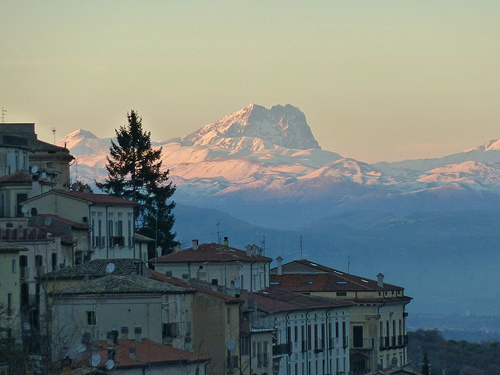
Pettorano sul Gizio by Cirdan il Timoniere
Where
Once considered one region under the Kingdom of the Two Sicilies (the largest of the Italian states from 1816 to 1860 before Italy was unified in 1861), today Abruzzo and Molise are two different regions collectively known as the Abruzzi . Abruzzo is in the northernmost part, bordering le Marche (the Marches), with Lazio to the west, the Adriatic Sea to the east, and Molise to the south.
Molise, in the southernmost portion of the region, flanks Lazio to the west and Campania to the southwest. Puglia (Apulia) lies to the southeast, with its eastern coast lapped by the Adriatic Sea, and Abruzzo along its northern border.

Gran Sasso by Pizzo di Sevo

Pescasseroli by Gigi62
Abruzzo and Molise are the most mountainous regions in Italy, with the Apennines running through their geographical hearts. Alternating between stark heights and deep green valleys these regions share a similar culinary heritage. Abruzzo was at the epicentre of the terrible earthquake that destroyed many of the region’s towns and villages in 2009, damaging many cultural treasures and buildings.
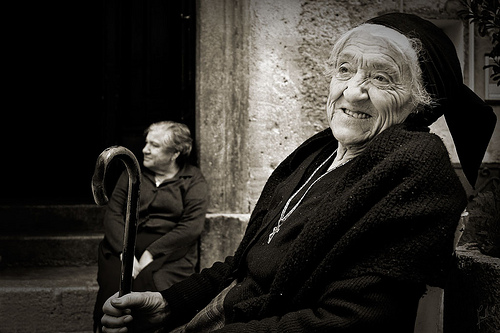
The Smile by Francesco Moscone
People from Abruzzo Molise are known for being strong, traditional, rustic, and genuine. Abruzzo is particularly known for its chefs from Villa Santa Maria who have for centuries cooked for royalty and heads of state.
What to See

Parco Nazionale Gran Sasso by Gigi62

Lago di Barrea by Gigi62
These regions are perfect for outdoors men for the many options it offers them, including hiking and visiting caves in the Parco Nazionale d’Abruzzo and Parco Nazionale della Majella (Abruzzo and Maiella National Parks). There is even skiing here! The Gran Sasso in Abruzzo is the highest mountain in Italy south of the Alps and is worth a visit for the view alone. There are many wild animals in the parks including wolves, brown bears, lynx, chamois, and golden eagles.

Bear in Parco Nazionale d’Abruzzo by Fspugna

Cow by Francesco Moscone
Sulmona in Abruzzo is worth visiting to see the Palazzo dell’Annunziata (a 14th century palace) and to buy candy, as it has a strong candy making industry. Chieti has a good Museo Archeologico Nazionale d’Abruzzo (archaeological museum), which houses a famous statue called the Warrior of Capestrano.

Confectionary in Sulmona by Giuseppesavo
Other recommended destinations include the scenic villages of Caramanico Terme, set on a hilltop in the Maiella Park with picturesque 15th century architecture and has the best honey in Italy (millefiori honey made by Caramanico da Pietro Amaroso); Castelli, a base camp for climbing the Gran Sasso which is known for painted tiles and artisanal meat, particularly turkey and porchetta cooked “alla canzanese”; Navelli, a stone village known for its saffron market in the autumn; and Santo Stefano di Sessanio, set in the Gran Sasso Park, it is considered one of the most beautiful villages in Abruzzo and it hosts an annual festival to celebrate its organic lentils (lenticchie di Santo Stefano di Sessanio).
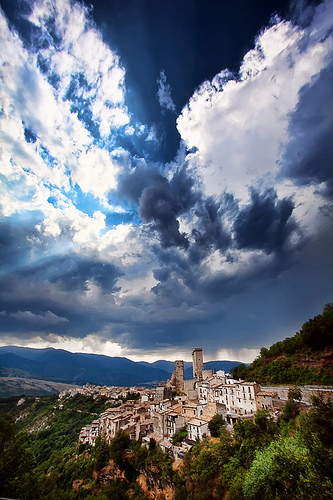
Pacentro by Christopher Schoenbohm

Chiesa di Santa Maria del Lago by Francesco Moscone
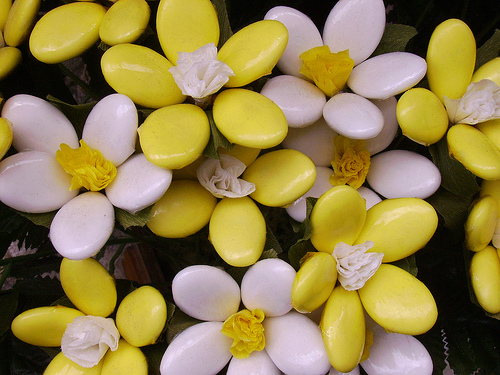
Confetti by Klio
Artisanal foods are in no short supply here. You can bring home the excellent honey of Molise, many different types of candy including confetti (sugar coated almonds) and torrone from Nurzia (a nougat with different flavours including chocolate or fig), dried maccheroni alla chitarra pasta, and sausages.
The Larder

Diavolicchi by Bwohack
Abruzzo is mainly known for its use of cheese in cooking and a penchant for hot chillies called diavolicchi. Molise’s signature ingredients include honey, vegetables, and cured pork products. The people in the coastal areas of Abruzzo Molise naturally eat more fish and seafood (particularly grilled) than elsewhere in the region, while mountain dwellers tend to eat more sheep, lamb, and cheese, particularly pecorino.

Sheep by Roamingwab
Inland areas have an abundance of farmed produce, particularly fruit, and livestock such as cattle, pigs, goats, and fowl. Pork is used for many unique and tasty sausages, which make thrifty use of the entire animal. This is one of the only areas in southern Italy where people eat polenta.
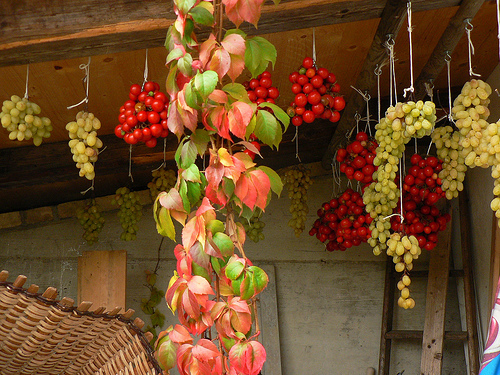
Tomatoes and grapes left to dry by Chrissam42
There is a promising growing trend of producing artisanal food products in Abruzzo Molise, including the use of free-range animals for tastier meat, and slow-drying handmade pastas for sale.

Olive trees by Duegnazio
Typical local ingredients include grapes, almonds, olives, wheat, oats, maize, potatoes, cardoons, fish, peas, carrots, cheese, figs, garlic sausages, ham, pears, saffron, sweet peppers, cannellini beans, broccoli, celery, fennel, onions, peaches, apricots, apples, turnip tops, pennyroyal, spinach, mint, marjoram, and chicory.
Menu
Abruzzo and Molise are known for high quality cooking, their love for spicy food, and for eating abundantly (despite being relatively poor). Their famous panarda is a lunch feast of no less than thirty to forty courses of seven dishes each, consumed over the course of a day. Guests cannot stop eating partway through the feast without offending the host. Another example of the propensity for generosity is a charming, if curious, wedding tradition–guests are expected to bring baskets to fill with food from the celebration; the more food guests take, the bigger compliment to the chef. The contrast between everyday frugality and such abundance at celebrations or similarly general rituals such as livestock slaughtering (which is an occasion of great feasting and opportunity to invite many guests and extended family) is quintessentially Italian.

Ladies by Piedozzino
Favourite dishes along the coast include: scapece (fried fish marinated in vinegar), fritto misto (deep-fried mixed seafood), and polpi in purgatorio (octopus cooked with chillies and tomatoes). Mountain fare includes the signature pasta shape of the region, maccheroni alla chitarra (square-edged spaghetti cut on a wire-stringed box, and often topped with meat sauce such as tomato sauce with cured pig’s cheek), lamb, sheep, and pecorino cheese dishes. Other typical specialties include include virtù (a soup of pork, pasta, vegetables, and herbs such as Roman mint, marjoram, and parsley), ‘ndocca ‘ndocca (a pork stew), and confectionary such as confetti and torrone. See recipes here.
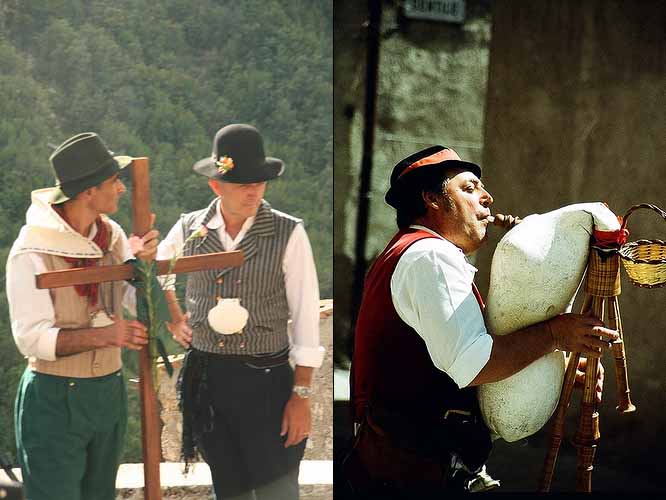
Men by Piedozzino (left) and Bagpipe by Orsosolo Sioux (right)
Favourite dishes particular to Molise include handmade fusilli with spicy tomato sauce, p’lenta d’Iragn (potatoes and wheat porridge served with tomato sauce), calcioni di ricotta rustici (fried pasta stuffed with ricotta, provolone, and prosciutto) and caragnoli (sweetened, ribbon-shaped fried dough drizzled with honey).
Good wines from the area include Montepulciano d’Abruzzo, a red table wine, and Trebbiano d’Abruzzo, a white wine, preferably made from Bombino grapes. Good producers of Montepulciano d’Abruzzo include Masciarelli, Villa Bizzari, Agriverde, and Col del Mondo while good producers of Trebbiano d’Abruzzo include Edoardo Valentini and Cirelli.
What to Eat
A list of typical dishes from Abruzzo Molise (the most classic dishes are written in bold):
Salumi (Cold Cuts)
Many of the salumi are named after their place of origin and have been made since ancient times.
Annoia di Ortona (sausage of pig stomach and intestines flavoured with chilli, garlic, orange zest, and fennel seed eaten fresh, roasted, or cooked in white wine)
Fegatazzo di Ortona (sausage made from pig liver and cheek flavoured with fennel, black peppercorn, and orange peel, and eaten grilled, broiled, or raw)
Fegato dolce (smoked, sweet pork sausage made from liver, offal, and belly flavoured with honey, candied citron and orange, pine nuts, and pistachios)
Fegato pazzo (a spicy pork sausage)
Guanciale amatriciano (cured and smoked pig’s cheek flavoured with pepper and chilli and aged, sliced thinly and served with grilled bread)
Mortadelle amitriciana / Mortadelle di Campotosto / Coglione di mulo (cured, smoked, pork sausage made from the shoulder with a chunk of lard in the centre)
Prosciutto affumicato (smoked, cured pork leg)
Saiggicciotta / Salsicciotto frentano (cured pork sausage seasoned with paprika, chilli, and fennel, stuffed into a bladder casing)
Salamella di tratturo / Salame di pecora (smoked sausage made from lean mutton, lardo, and pancetta flavoured with chilli and juniper berries; sometimes preserved in oil flavoured with dill or cumin)
Salsicce di fegato di Rionero Sannitico (pork sausage of lean meat, lung, liver, heart, and lard and preserved in pork fat)
Salsicciotto di Guilmi (a prized pork sausage consisting of meat primarily from the loin, preserved in olive oil or fat)
Sopressata di Rionero Sannitico (pork sausage made from coarsely ground loin, head, neck, and bacon with lardo)
Ventricina di Crognaleto (a smoked and fatty spreadable pork sausage flavoured with paprika and chilli in a pig’s stomach or bladder casing)
Ventricina di Guilmi (pork sausage made with finer cuts of the animal and flavoured with fennel seeds and orange peel)
Ventricina di Montenero di Bisaccia (a spreadable pork sausage primarily of lean leg meat)
Antipasti (Starters)
Bruschetta (grilled bread rubbed with garlic and drizzled with extra-virgin olive oil)
Calcioni di ricotta rustici (deep-fried yeasted dough stuffed with ricotta, provolone, and prosciutto, served with deep-fried croquettes, artichokes, scamorza cheese, cauliflower, calf’s brain, and sweetbreads)
Frittatine di patate e zafferano (pan-fried saffron-flavoured potato cakes)
Mozzarelline allo zafferano (breaded, deep-fried mozzarella cheese flavoured with saffron)
Scamorze allo spiedo (roasted scamorza cheese on skewers)
Primi (First Courses)
Brodosini (fresh tagliatelle pasta with fried guanciale in broth)
Cardone in brodo (cardoon soup with eggs, chicken livers, meatballs cooked in capon or turkey broth and sprinkled with pecorino cheese–typically served at Christmas)
Cavatelli al ragù (rolled short pasta with a lamb meat sauce)
Ciufele e tanne de rape (pasta shaped by rolling around a needle served with turnip tops)
Fettuccine al’abruzzese (fettucine pasta with lardo or pancetta, pecorino, onion, parsley, and basil)
Fusilli alla Molisana (fusilli pasta with spicy tomato sauce)
Lasagna abruzzese (fresh pasta sheets layered with veal and beef meat sauce, hard-boiled egg, and scamorza and pecorino cheeses)
Maccheroni alla chitarra / Cavatelle alla chitarra (square-edged spaghetti cut on a stringed box — served with tomato sauce, tiny meatballs, and pecorino cheese)
Minestra marinara / Minestra con brodo di pesce (seafood soup made from squid, sole, mullet, clams, hake, dogfish, oil, garlic, parsley, chilli, and lemon juice)
‘Ndoc ‘ndoc (a grilled pork sausage that is made from the ears, snout, liver, and spleen stuffed into intestine casings)
P’lenta d’iragn (potatoes and wheat porridge served with tomato sauce)
Pasta con ragù d’agnello e peperoni (maccheroni alla chitarra pasta with a lamb and pepper sauce)
Pasta con sugo di castrato (maccheroni alla chitarra pasta with a tomato and mutton sauce flavoured with bacon, wine, rosemary, and onion)
Pasta e fagioli con zampino e cotenne (tube pasta and bean soup with pig’s trotter, tail, and skin)
Pizza rustica (short-crust pastry pie stuffed with sausage or ham, mozzarella and parmigiano-reggiano cheeses, and eggs)
Polenta e tordiglioni (polenta with green vegetables sautéed in oil, garlic, and chilli)
Polenta sulla spianatora (polenta with tomato and sausage sauce)
Ravioli abruzzesi (stuffed square pasta envelopes with ricotta, served with veal or beef meat sauce)
Spaghetti aglio, olio, e peperoncino (spaghetti pasta with garlic, plenty of chilli, extra-virgin olive oil, and parsley)
Spaghetti al sugo (spaghetti pasta with tomato sauce)
Timballo di screspelle (crepe-lined tart filled with alternating layers of crepe, maccheroni alla chitarra dressed with lamb meat sauce, meatballs, eggs, and scamorza, and parmigiano-reggiano cheeses)
Vermicelli in salsa abruzzese (thin spaghetti pasta with zucchini flowers, egg, saffron, onion, and parsley sauce)
Virtù (soup of pork, seven types of dried and fresh beans, seven types of mixed pasta shapes, spring vegetables, and seven types of herbs; eaten on the 1st of May to signify the end of winter and the beginning of spring)
Zuppa di cardi Aquilani (cardoon soup with meatballs)
Zuppa di lenticchie (lentil soup flavoured with garlic and olive oil and served with bread fried in olive oil)
Zuppa di ortiche (nettle soup)
Secondi (Main Courses)
Acciughe all’abruzzese (deep-fried anchovies)
Agnello alla scannese (roasted lamb with garlic and rosemary)
Agnello cacio e uova (lamb stew flavoured with ham, onion, white wine, eggs, pecorino cheese, and lemon juice)
Agnello alle olive (lamb stew with olives, chilli, oregano, and lemon)
Agnello brodettato (lamb stew with prosciutto and white wine in a lemon egg sauce)
Alenoto di agnello o di capretto (lamb or goat heart, liver, and lights combined with parsley, garlic, and chilli into a meatloaf and wrapped in intestines)
Arrosticini / L’rrustelle (barbecued lamb or mutton on skewers)
Brodetto vastese (fish and seafood soup with onions, tomatoes, parsley, olive oil, and chilli)
Capra alla neretese (goat stew with tomatoes, sweet peppers, chilli, and herbs)
Frittata al basilico (basil omelette)
Fritto misto (deep-fried mixed seafood)
Intingolo di castrato (ribs of castrated lamb braised with pancetta, oregano, parsley, onion, celery, carrot, and white wine)
Involtini con fagioloni (veal rolls stuffed with veal, pork, mushrooms, garlic, parsley, and pecorino or parmigiano-reggiano cheese, served with beans and tomatoes)
Mazzarelle (pan-fried lamb innards flavoured with herbs, tied into bundles, wrapped in endive leaves)
‘Ndocca ‘ndocca (pork stew made from snout, ears, trotters, ribs, skin, and cheek flavoured with rosemary, bay leaf, and chilli)
Pastuccia (polenta cake with fresh sausage, raisins, eggs, and bacon)
Polpi in purgatorio (octopus simmered with chillies, tomatoes, oil, garlic, and parsley)
Rosticini (roasted lamb cut into pieces)
Scapece (fried fish marinated in vinegar and saffron)
Stoccafisso all’abruzzese (stockfish stewed with potato, tomato, mushroom, onion, chilli, garlic, parsley, and spices)
Tacchino alla canzanese (whole roasted boneless turkey flavoured with herbs and slow-cooked with the bones, typically served at Christmas lunch)
Triglie al cartoccio (baked mullet wrapped in parchment)
Contorni (Side Dishes)
Carciofi ripieni (braised artichokes stuffed with preserved tuna, anchovies, capers, parsley, and garlic)
Cipollacci all’abruzzese (deep-fried, battered onions)
Patate sotto il coppo (pan-fried potatoes)
Piselli con guanciale (peas sautéed with cured guanciale and onion)
Dolci (Desserts)
Bocconotti dolci (little tarts filled with cooked grape must and chocolate)
Caragnoli (fried, ribbon-shaped sweet dough drizzled with honey)
Cassata abruzzese (a cake filled with nougat, chocolate, almond brittle, and cream)
Ciambelline campagnole (doughnut-shaped sugar cookies)
Confetti (sugar-coated almonds traditionally eaten at weddings and celebrations)
Ferratelle / Pizzelle / Coperchiole (anise-flavoured waffle cookie sandwiches filled with grape jam)
Parrozzo abruzzese (almond and orange cake glazed with dark chocolate icing)
Pizza dolce (layered sponge cake with three different types of cream fillings: chocolate, almond, and sweet cream)
Sanguinaccio / Sfarricciato (blood sausage made with nuts, pine nuts, raisins, orange peel, cocoa, spelt, and streaky bacon)
Torrone al cioccolato (soft nougat with hazelnuts and chocolate)
Torrone di fichi secchi / Torrone di Chieti (nougat with almonds, chocolate, and dried figs)
Formaggi (Cheeses)
Caciocavallo di Agnone (a solid, semi-mature, pear-shaped, cow’s milk cheese similar to mozzarella which is semi-firm and ranges from creamy and sweet when young to sharp when matured, from Molise)
Caciofiore aquilano (a fresh, soft, creamy, ewe’s milk cheese, sometimes coloured with saffron, from L’Aquila)
Canestrato di Castel del Monte (a firm, sharp, tangy, ewe’s milk cheese made in baskets in L’Aquila)
Pampanella (a goat’s milk cheese wrapped in grape leaves, from L’Aquila)
Pecorino abruzzese (a solid, semi-mature, ewe’s milk cheese, from Abruzzo)
Scamorza (a plastic-textured, firm, pear-shaped cheese similar to mozzarella, made from cow’s milk, from Abruzzo and Molise but the scamorza from Upper Molise are the best. Scamorza is tasty broiled.)
Stracciata (a fresh, coagulated, cow’s milk cheese, eaten fresh with cold cuts or salad, from Agnone and the Upper Molise area)
Bevande (Drinks)
Centerbe (a liqueur made from 100 herbs)
Ratafia (a liqueur of fortified red wine, sugar, sour cherries, vanilla, and cinnamon)



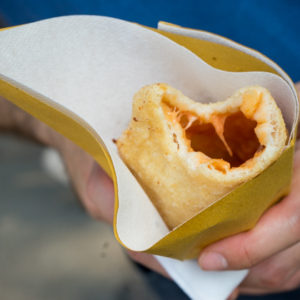

Leave a Reply